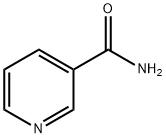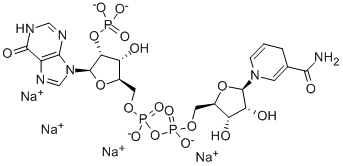NADP sodium salt
Synonym(s):β-Nicotinamide adenine dinucleotide phosphate disodium salt;β-NADH phosphate disodium salt;β-NADP-Na2;β-Nicotinamide-adenine Dinucleotide Phosphate, TPN, Co II, Na;Triphosphopyridine nucleotide disodium salt
- CAS NO.:1184-16-3
- Empirical Formula: C21H29N7NaO17P3
- Molecular Weight: 767.41
- MDL number: MFCD00036973
- EINECS: 214-664-6
- SAFETY DATA SHEET (SDS)
- Update Date: 2024-11-19 23:02:33

What is NADP sodium salt ?
Description
The nicotinamide adenine dinucleotide phosphate oxidase(NADP)is a multicomponent system that transfers an electron to molecular oxygen by way of FAD and heme to form superoxide (O2?) .Cytochrome b558 is a membrane-bound heterodimer lodged in the wall of the secondary granules; the large glycosylated β subunit is gp91phox and the small nonglycosylated α subunit is p22phox.The cytoplasmic tail of gp91phox binds FAD, heme, and NADPH, which are required for electron transfer to oxygen (O2).Neutrophil stimulation leads to aggregation and phosphorylation of p47phox, p67phox, p40phox, and the small guanosine triphosphate (GTP)–binding proteins RAC1/RAC2, which dock with the cytochrome at the membrane through binding of p47phox and p22phox.
Description
Nicotinamide adenine dinucleotide phosphate, abbreviated NADP+ or, in older notation, TPN (triphosphopyridine nucleotide), is a cofactor used in anabolic reactions, such as the Calvin cycle and lipid and nucleic acid syntheses, which require NADPH as a reducing agent ('hydrogen source').It is used by all forms of cellular life.
Chemical properties
White to slightly yellowish powder
The Uses of NADP sodium salt
β-Nicotinamide adenine dinucleotide 2′-phosphate (NADP+) and β-Nicotinamide adenine dinucleotide 2′-phosphate, reduced (NADPH) comprise a coenzyme redox pair (NADP+:NADPH) involved in a wide range of enzyme catalyzed oxidation reduction reactions.
β-Nicotinamide Adenine Dinucleotide Phosphate Sodium Salt Hydrate is a substrate NADP which plays a role in a variety of metabolic processes.
The Uses of NADP sodium salt
β-Nicotinamide adenine dinucleotide phosphate monosodium salt acts as an electron acceptor used by cells. It is also useful in vitro to study NADP. Furthermore, it is used in a wide range of enzyme catalyzed oxidation reduction reactions. The combination of NADP+/NADPH is employed in a variety of antioxidation mechanisms, which protect against reactive oxidation species accumulation.
What are the applications of Application
NADP monosodium salt is a coenzyme that is widely distributed in living matter
Biosynthesis
In general, NADP+ is synthesized before NADPH is. Such a reaction usually starts with NAD+ from either the de-novo or the salvage pathway, with NAD+ kinase adding the extra phosphate group. ADP-ribosyl cyclase allows for synthesis from nicotinamide in the salvage pathway, and NADP+ phosphatase can convert NADPH back to NADH to maintain a balance.Some forms of the NAD+ kinase, notably the one in mitochondria, can also accept NADH to turn it directly into NADPH.[3][4] The prokaryotic pathway is less well understood, but with all the similar proteins the process should work in a similar way.
Biochem/physiol Actions
Electron acceptor
Mechanism of action
NADP sodium salt exerts its effect by competitively inhibiting nucleotide metabolism through the suppression of enzymes like nucleoside diphosphate kinase (NDPK) and adenosine kinase (ADK). Additionally, it serves as a substrate for enzymes like DNA polymerases and RNA polymerases, enabling the integration of NADP monosodium salt into nucleic acids during replication and transcription.
Properties of NADP sodium salt
| Melting point: | 175-178 °C (dec.)(lit.) |
| storage temp. | -20°C |
| solubility | H2O: 50 mg/mL |
| form | powder |
| color | off-white to yellow |
| PH | 2.0-4.0 |
| Water Solubility | Soluble in water. |
| Merck | 14,6344 |
| BRN | 4779954 |
Safety information for NADP sodium salt
Computed Descriptors for NADP sodium salt
| InChIKey | JNUMDLCHLVUHFS-QYZPTAICSA-M |
NADP sodium salt manufacturer
Anand Agencies
New Products
(S)-3-Aminobutanenitrile hydrochloride 4-Methylphenylacetic acid N-Boc-D-alaninol N-BOC-D/L-ALANINOL Tert-butyl bis(2-chloroethyl)carbamate 3-Morpholino-1-(4-nitrophenyl)-5,6-dihydropyridin- 2(1H)-one Furan-2,5-Dicarboxylic Acid Tropic acid 1-Bromo-3,5-Di-Tert-Butylbenzene S-2-CHLORO PROPIONIC ACID ETHYL ISOCYANOACETATE 2-Bromo-1,3-Bis(Dimethylamino)Trimethinium Hexafluorophosphate 4-IODO BENZOIC ACID 3-NITRO-2-METHYL ANILINE 1-(2,4-DICHLOROPHENYL) ETHANAMINE (2-Hydroxyphenyl)acetonitrile 4-Bromopyrazole 2-(Cyanocyclohexyl)acetic acid 4-methoxy-3,5-dinitropyridine 1-(4-(aminomethyl)benzyl)urea hydrochloride 2-aminopropyl benzoate hydrochloride diethyl 2-(2-((tertbutoxycarbonyl)amino) ethyl)malonate tert-butyl 4- (ureidomethyl)benzylcarbamate Ethyl-2-chloro((4-methoxyphenyl)hydrazono)acetateRelated products of tetrahydrofuran








You may like
-
 beta-Nicotinamide adenine dinucleotide phosphate monosodium salt CAS 1184-16-3View Details
beta-Nicotinamide adenine dinucleotide phosphate monosodium salt CAS 1184-16-3View Details
1184-16-3 -
 beta-Nicotinamide adenine dinucleotide phosphate monosodium salt CAS 1184-16-3View Details
beta-Nicotinamide adenine dinucleotide phosphate monosodium salt CAS 1184-16-3View Details
1184-16-3 -
 ß-Nicotinamide Adenine Dinucleotide Phosphate Monosodium Salt (ß-NADP.Na CAS 1184-16-3View Details
ß-Nicotinamide Adenine Dinucleotide Phosphate Monosodium Salt (ß-NADP.Na CAS 1184-16-3View Details
1184-16-3 -
 B-Nicotinamide adenine dinucleotide phosphate sodium salt CAS 1184-16-3View Details
B-Nicotinamide adenine dinucleotide phosphate sodium salt CAS 1184-16-3View Details
1184-16-3 -
 beta-Nicotinamide adenine dinudeotide phosphate sodium salt (NADP) 97.00% CAS 1184-16-3View Details
beta-Nicotinamide adenine dinudeotide phosphate sodium salt (NADP) 97.00% CAS 1184-16-3View Details
1184-16-3 -
![β-Nicotinamide Adenine Dinucleotide Phosphate Sodium Salt Hydrate, oxidized form [for Biochemical Research] CAS 1184-16-3](https://img.chemicalbook.in//Content/image/CP5.jpg) β-Nicotinamide Adenine Dinucleotide Phosphate Sodium Salt Hydrate, oxidized form [for Biochemical Research] CAS 1184-16-3View Details
β-Nicotinamide Adenine Dinucleotide Phosphate Sodium Salt Hydrate, oxidized form [for Biochemical Research] CAS 1184-16-3View Details
1184-16-3 -
 NADP, Monosodium Salt CAS 1184-16-3View Details
NADP, Monosodium Salt CAS 1184-16-3View Details
1184-16-3 -
 β-Nicotinamide adenine dinucleotide phosphate sodium salt CAS 1184-16-3View Details
β-Nicotinamide adenine dinucleotide phosphate sodium salt CAS 1184-16-3View Details
1184-16-3